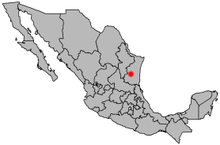Pinguicula laxifolia
| Pinguicula laxifolia | ||||||||||||
|---|---|---|---|---|---|---|---|---|---|---|---|---|

Summer rosette of Pinguicula laxifolia |
||||||||||||
| Systematics | ||||||||||||
|
||||||||||||
| Scientific name | ||||||||||||
| Pinguicula laxifolia | ||||||||||||
| Luhrs |
Pinguicula laxifolia is a carnivorous plant from the genus of the fatty herbs ( Pinguicula ) and the only member of the Orchidioides section. It wasfirst describedin 1995 by Hans Luhrs on the basis of collections from 1969 .
description
Pinguicula laxifolia is a perennial, herbaceous plant , belongs to the tropical-heterophyllous growth type and accordingly forms a summer and a winter rosette, both of which are down to earth. The root system consists of numerous white, thin and unbranched roots.
The loose summer rosette is made up of drooping, elliptical to inverted-lanceolate leaves , which are 4 to 6.8 inches long and 6 to 12 millimeters wide, the petiole makes up around a third of the length. The drooping leaves are unusual, as the majority of the species in the genus are characterized by stiff, almost succulent leaves.
In the dry winter, Pinguicula laxifolia forms a dense winter rosette from up to seventeen short, obovate to spatulate, non-carnivorous leaves with a length of 1 to 1.7 centimeters and a width of 1.5 to 4 millimeters.
Pinguicula laxifolia blooms from February to March, the flowers are pink to pale purple, with a white sap mark and darker purple markings.
Distribution and habitat
Pinguicula laxifolia is only known from its remote typort in the "El Cielo" cloud forest bio-reserve in Tamaulipas , Mexico . Here it grows on heavily shaded, vertical rock walls at an altitude of 1920 to 2040 m. ü. NN. Due to its extremely limited distribution, little is known about the species.
literature
- Hans Luhrs: New additions to the genus Pinguicula (Lentibulariaceae) of Mexico. In: Phytologia. Vol. 79, No. 2, 1995, ISSN 0031-9430 , pp. 114-122 .
Web links
- Photos and description of the habitat (English)
